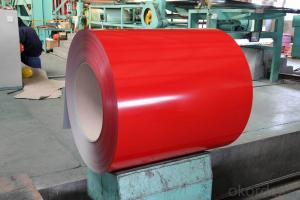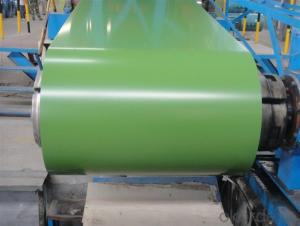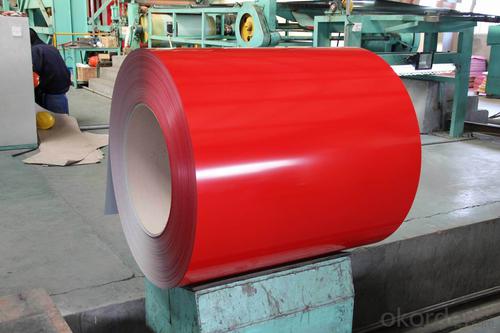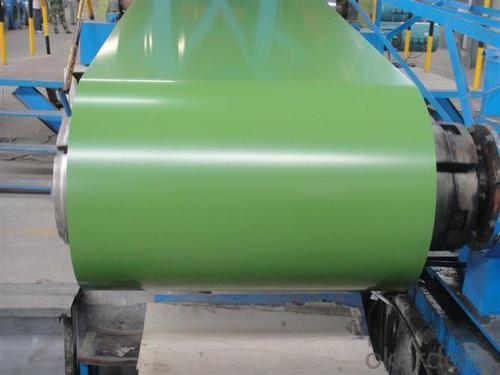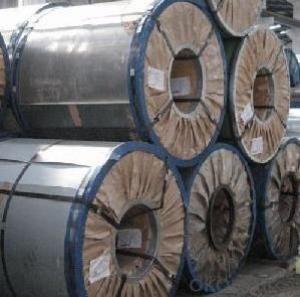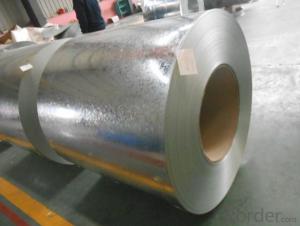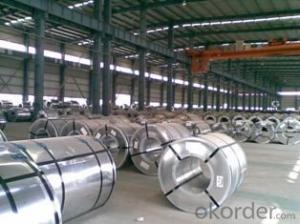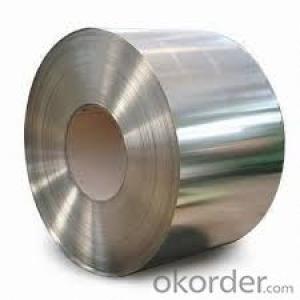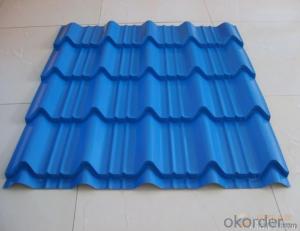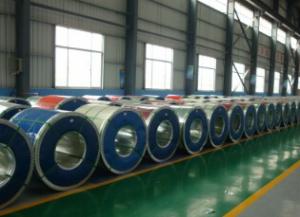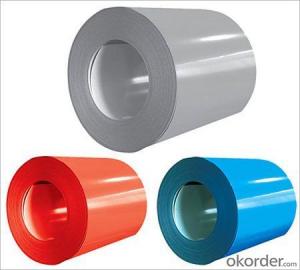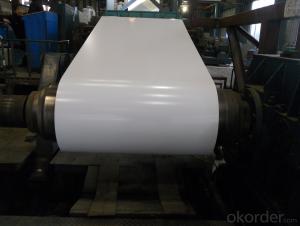Prepainted Aluzinc Steel Sheet in coils
- Loading Port:
- China Main Port
- Payment Terms:
- TT OR LC
- Min Order Qty:
- -
- Supply Capability:
- -
OKorder Service Pledge
OKorder Financial Service
You Might Also Like
Quality Q/BQB440-2003 JIS G3312-1994 EN 10326-2004 ASTM A653-02a
EN 10327-2004(BASE PLATE)
(BASEPLATE)
Commercial SteelTDC51D CGCC DX51D+Z/AZ CS Type A/B/C
Forming Steel(TSt01,TSt02,TSt03) CGCD1 FS Type A, Type B
Drawing TDC52D/TDC53D - DX52D+Z/AZ DDS TYPE A/C
Steel DX53D+Z/AZ
StructuralTS280GD(TStE28) CGC400 S280D+Z/AZ SS275
SteelTS350GD(TStE34) CGC440 S350D+Z/AZ SS340 Class1
ManufacturerThickness Width Length of plate Inner diameter of coil
JIANGSU HUIYESTEEL SHEET CO.,LTD 0.2-1.2mm 800/914/1000/1200/1219/1250mm 1000-6000mm508mm/610mm
Coated Mass OF(Prepainted galvanized steel coils) printed PPGI coils:
Base plateAvailable Coated Mass(g/m^2)
Galvanized Steel80, 100, 120, 160, 180
Galvalume Steel50, 70, 150
AvailablePainting OF (Prepainted galvanized steel coils) printed PPGI coils:
Category ofPainting Item Code
Polyester PE
High-durabilitypolyester HDP
Silicon modifiedpolyesters SMP
Polyvinylidenefluoride PVDF
Easy-Cleaning —
PaintingThickness Top side: 20+5microns;
Bottom side:5~7microns.
Color SystemProduce according to RAL Color System or as per buyer’s color sample.
Paintingstructure Top surface Bottom surface
Primer coatingNo coating 1/0
Primer coatingPrimer coating 1/1
Primer coating +Finish coating No coating 2/0
Primer coating +Finish coating Primer coating or single back coating 2/1
Primer coating +Finish coating Primer coating + Finish back coating 2/2
- Q: How are steel coils used in the manufacturing of tools and equipment?
- Steel coils are used in the manufacturing of tools and equipment as they provide a versatile and durable material for construction. These coils are typically shaped, cut, and molded into various components such as blades, shafts, and handles, which are then assembled to create the final product. The strength and resilience of steel make it an ideal choice for tools and equipment, ensuring longevity and optimal performance in various industries.
- Q: All the appliances in my kitchen are stainless steel, and I hate how they look becuase every time I wash them they are full of streaks. Is there a good cleaner made for stainless steel that won't leave streaks?
- WD40 is great for cleaning stainless steel anything for some reason it protects it from finger prints things so you won't have to clean it as often. WD40 is great for thousands of other uses too, it can remove stickers, dried paint from glass, wipes away crayon wax, lubricates squeeky parts, spray it on your lawnmower or bike before you put it away for winter it'll come out in spring rust free.... so you'll get more than your moneys worth from a small tin.
- Q: How are steel coils used in the manufacturing of automotive body panels?
- Steel coils are used in the manufacturing of automotive body panels because they provide a strong and durable material that can be easily shaped and formed into the desired panel shapes. The coils are unwound and fed into a stamping press where they are cut, shaped, and molded into the specific body panel design. This process ensures that the panels have the necessary strength and structural integrity required for automotive applications.
- Q: How are steel coils processed at the steel service centers?
- Steel coils are processed at steel service centers through a series of steps. First, the coils are unrolled and flattened using a decoiler and a leveling machine. Then, the steel is cut into the desired length and width using shears or slitting machines. Next, the coils may undergo various treatments such as pickling, galvanizing, or coating to enhance their corrosion resistance or appearance. Finally, the processed coils are inspected, packaged, and prepared for shipment to various industries for further manufacturing or construction purposes.
- Q: What is stainless steel 316, and what are its properties and uses?
- 316 is the second most common grade (after 304); for food and surgical stainless steel uses; alloy addition of molybdenum prevents specific forms of corrosion. It is also known as marine grade stainless steel due to its increased resistance to chloride corrosion compared to type 304. 316 is often used for building nuclear reprocessing plants. 316L is an extra low carbon grade of 316, generally used in stainless steel watches and marine applications, as well exclusively in the fabrication of reactor pressure vessels for boiling water reactors, due to its high resistance to corrosion. 316Ti includes titanium for heat resistance, therefore it is used in flexible chimney liners.
- Q: Is Stainless steel called that because.....a. Its stains lessORb. Its virtually stainless (it can't stain).Lol do you know the correct answer?????
- a. is the correct answer. It will still show tea and coffee stains. I find using baking soda is a good way to clean it and freshens the drains of the sinks as well. If cleaning your refrigerator a glass cleaning spray works well, just be sure to dry it thoroughly.
- Q: What is the standard thickness of steel coils?
- The specific application and industry requirements dictate the standard thickness of steel coils, which can vary. Generally, steel coils are obtainable in thicknesses ranging from 0.5mm to 10mm. Various factors, including intended use, structural requirements, and manufacturing processes, influence the desired thickness of a steel coil. Heavier applications that necessitate increased strength and durability typically employ thicker coils. Conversely, thinner coils are suitable for lighter applications where flexibility and weight reduction are crucial. To determine the appropriate thickness for steel coils in a particular application, it is essential to consult industry standards and specific project requirements.
- Q: In the warehouse management system of steel coil
- The warehouse is set to be required under the factories and production equipment and manpower planning, reasonable layout; to strengthen the internal economic responsibility system, scientific division, forming material export management assurance system; the service must implement the work quality standard > standardization, application of modern management technology and the ABC classification method, and constantly improve the level of warehouse management.
- Q: Are steel coils affected by temperature changes?
- Yes, steel coils are affected by temperature changes. Steel is a metallic material that expands when heated and contracts when cooled. Temperature fluctuations can cause steel coils to expand or contract, which may impact their dimensions, mechanical properties, and overall performance. It is important to consider and manage temperature changes to ensure the proper functioning and durability of steel coils.
- Q: What are the different surface finishes available for steel coils?
- There are several different surface finishes available for steel coils, including hot rolled, cold rolled, galvanized, coated, and polished finishes.
Send your message to us
Prepainted Aluzinc Steel Sheet in coils
- Loading Port:
- China Main Port
- Payment Terms:
- TT OR LC
- Min Order Qty:
- -
- Supply Capability:
- -
OKorder Service Pledge
OKorder Financial Service
Similar products
Hot products
Hot Searches
Related keywords
